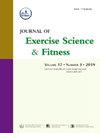Sex-stratified compositional analysis of 24-h movement behaviors and their relationship with selective attention and cognitive flexibility in socioeconomically vulnerable children
IF 2.4
2区 医学
Q2 SPORT SCIENCES
引用次数: 0
Abstract
Introduction
The 24-h movement behavior framework, which integrates physical activity (PA), sedentary behavior, and sleep, acknowledges the co-dependent nature of time-use behaviors within a finite day. While these behaviors have been linked to cognitive performance in children, few studies have applied compositional data analysis (CoDA), and none have examined potential sex differences.
Objective
To explore sex-specific associations between 24-h movement behavior compositions and selective attention and cognitive flexibility in a sample of socioeconomically vulnerable Chilean children using CoDA.
Methods
Baseline data from 161 children (8–10 years old) participating in the Active-Start trial were analyzed. Movement behaviors were assessed via 9-day wrist-worn accelerometers. Selective attention was assessed using the d2 Test of Attention, and cognitive flexibility was measured with the Design Fluency Test.
Results
Boys accumulated more moderate-to-vigorous PA (MVPA; 83.5 [57.6–109.7] min) than girls (67.7 [52.3–78.1] min), whereas girls engaged in more light PA (219.9 ± 37.7 min) than boys (205.7 ± 38.1 min; P < 0.05). Among boys, reallocating daily time to MVPA at the expense of other behaviors was associated with increased processing speed (unstandardized-beta [B] = 53.501, 95 %confidence-interval [CI] 14.393; 92.609, P = 0.008) and concentration (B = 25.099, 95 %CI 4.816; 45.382, P = 0.016), as well as cognitive flexibility (B = 5.913, 95 %CI 1.995; 9.832, P = 0.004). No significant associations were observed in girls (P > 0.05). A non-significant association was observed linking sedentary behavior with cognitive performance in both sexes.
Conclusion
These findings highlight potential sex-specific benefits of MVPA and support the use of CoDA in understanding how daily time use relates to cognitive performance in children.
社会经济弱势儿童24小时运动行为的性别分层组成分析及其与选择性注意和认知灵活性的关系
24小时运动行为框架整合了身体活动(PA)、久坐行为和睡眠,承认在有限的一天内时间使用行为的相互依赖性质。虽然这些行为与儿童的认知表现有关,但很少有研究应用成分数据分析(CoDA),也没有研究潜在的性别差异。目的探讨智利社会经济弱势儿童24小时运动行为构成与选择性注意和认知灵活性的性别相关性。方法对参与Active-Start试验的161名儿童(8-10岁)的基线数据进行分析。通过9天的腕带加速度计评估运动行为。使用d2注意力测试评估选择性注意力,使用设计流畅性测试测量认知灵活性。结果男孩累积的中重度PA (MVPA; 83.5 [57.6-109.7] min)多于女孩(67.7 [52.3-78.1]min),而女孩累积的轻度PA(219.9±37.7 min)多于男孩(205.7±38.1 min; P < 0.05)。在男孩中,以牺牲其他行为为代价将日常时间重新分配给MVPA与处理速度(非标准化贝塔系数[B] = 53.501, 95%置信区间[CI] 14.393; 92.609, P = 0.008)和注意力(B = 25.099, 95% CI 4.816; 45.382, P = 0.016)以及认知灵活性(B = 5.913, 95% CI 1.995; 9.832, P = 0.004)相关。在女孩中未观察到显著相关性(P > 0.05)。研究发现,在两性中,久坐行为与认知能力之间并无显著关联。结论:这些发现突出了MVPA潜在的性别特异性益处,并支持使用CoDA来理解儿童日常时间使用与认知表现的关系。
本文章由计算机程序翻译,如有差异,请以英文原文为准。
求助全文
约1分钟内获得全文
求助全文
来源期刊
CiteScore
5.10
自引率
3.60%
发文量
54
审稿时长
31 days
期刊介绍:
The Journal of Exercise Science and Fitness is the official peer-reviewed journal of The Society of Chinese Scholars on Exercise Physiology and Fitness (SCSEPF), the Physical Fitness Association of Hong Kong, China (HKPFA), and the Hong Kong Association of Sports Medicine and Sports Science (HKASMSS). It is published twice a year, in June and December, by Elsevier.
The Journal accepts original investigations, comprehensive reviews, case studies and short communications on current topics in exercise science, physical fitness and physical education.

 求助内容:
求助内容: 应助结果提醒方式:
应助结果提醒方式:


